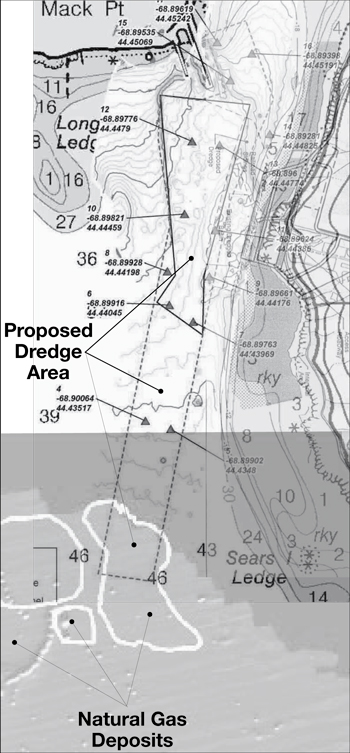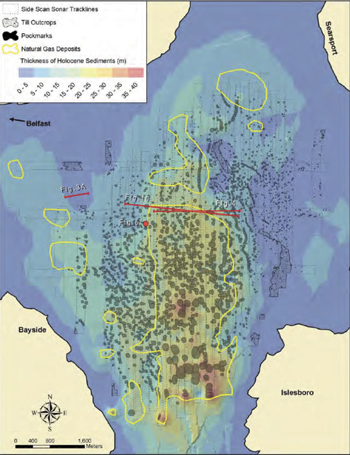Searsport Dredging Seen as Fishery Threat
continued from Homepage

Steve Miller, Executive Director, Ilseboro Islands Trust. Gas deposits at bottom were super imposed on the map from seafloor mapping conducted by the U.S. Geological Survey.
operate the Mack Point Marine Intermodal Cargo Terminal, while substantially damaging a public resource and the livelihoods of fishermen in the small surrounding fishing communities.
“Upper Penobscot Bay has a strong lobster resource with significant benefit to the local economy, and any disturbance will certainly have a negative impact upon the local economy, and more far-reaching impact on areas further down the bay,” said David Black, a Belfast lobster fisherman in upper Penobscot Bay since 1964. “Please have some consideration for those of us who have survived on this bay for decades and, in some cases, for generations, and find some other means of disposing of the Mack Point dredge spoils.”
“This is an extremely productive area. Some of the best fishing I’ve ever seen has come out of this area,” said Deer Isle lobster fisherman Julie Eaton, secretary/treasurer of the Maine Lobstering Union. “The economic impact to the lobstermen in this area, and even down my way as the silt drifts down, is going to be phenomenal. Why would this even been considered?”
Two marine geologists, Joseph Kelley and David Lang, speaking separately, said the Penobscot Bay seafloor is uniquely characterized by pockmarks—steep-walled craters likely caused by the release of underground methane, probably created by the anaerobic breakdown of ancient organic matter. They said seismic and acoustic studies, as well as the steep-walled nature of the craters, show that methane is still actively venting. The proposed disposal site comprises scores of these vents, they said. If spoils were dumped on the craters, they said, gas would likely vent through the spoils and create years of turbidity that would potentially damage marine organisms and habitat not only in the immediate area but, carried by the tide and currents, further afield.
“My impression is, if spoil is placed on top of these pits, then whatever process is maintaining the geographic form of the pits is going to come up through the sediment deposited there, and that’s virtually certain to create massive turbidity in the water which will definitely deleteriously affect the fishery,” said Lang.
The DMR hearing was meant to take comment on the impact to fisheries of the dredge operation and the haul route. But most speakers attended in order to comment on the proposed disposal site. The DMR said it would forward those comments to the Department of Environmental Protection, the agency charged with hearing those comments. The DEP will hold its own hearing on the subject at a later date, the DMR said.
The U.S. Army Corps of Engineers is proposing a Navigation Improvement Project for the existing channel entrance and turning basin to Searsport Harbor. According to the corps’ environmental assessment, the federal navigation channel and basin were constructed in 1964. No maintenance dredging has been performed since then.
The proposed project would deepen the channel from 35 feet to 40 feet at mean low water. The entrance channel would be widened from 500 feet at its narrowest point to 650 feet, and a maneuvering area adjacent to State Pier’s east berth would be created. The proposed dredged material, approximately 929,000 cubic yards of silty-clay, would be removed from the channel in scows and towed by tug to be deposited in Penobscot Bay, at an open-water disposal site with no confining or capping structure. The projected cost is $11 million in a 75/25 federal/state cost-share.

Gas field and associated pockmarks, Belfast Bay (Rogers et al., 2006).
According to the Maine Port Authority (MPA) website, the MPA manages the Port of Searsport. The port is one of five official cargo ports in the State of Maine, is the second largest deep-water port, and is the state’s second busiest industrial port in the state, behind Portland. Located at the head of Penobscot Bay, the port ships imports and exports and distributes goods throughout the United States and Canada via its on-site rail yard.
The Mack Point Marine Intermodal Cargo Terminal is the port’s main liquid and dry cargo-handling facility. The State Pier handles most of the dry bulk products such as road salt and gypsum. To the west of the State Pier is the Sprague Energy pier, which handles petroleum and other liquid bulk products, primarily for the Sprague Energy Corporation and Irving Petroleum.
According to the corps’ environmental assessment, the project is necessary because, since completion of the new State Pier and upgrades to the petroleum terminals, the size of ships calling on the terminal has increased. “As a consequence, the existing controlling depths in the Searsport channel are inadequate for existing and projected future vessel traffic,” the assessment says. “While the current fleet can access the Mack Point berths, a number of navigational inefficiencies exist due to the existing depths, which results in higher transportation costs. Among these inefficiencies are: tidal delays, light loading of vessels, the inability to switch to larger vessels, the inability to attract liner cargo service, and limits to future imports and exports at Searsport due to channel depths restricting the size of prospective vessels. In addition, the navigation pilots stated that the constriction mid-way between the channel entrance and the turning area requires widening to support the maneuvering of larger vessels. Without channel improvements, the commercial potential of the new State Pier will not be realized and existing navigational inefficiencies will continue. Project improvements will also provide more room to maneuver the larger ships that use the port.”
The assessments says material from the entrance channel, turning basin, and Long Cove maneuver area were tested for physical and chemical characteristics to determine if it would be suitable for unconfined open-water disposal. “Based on similar physical and chemical characteristics at the dredge and disposal sites, it was determined that the material from the Searsport Harbor would be suitable for disposal in Penobscot Bay at the Penobscot Bay Disposal Site,” the assessment says. The disposal site is located approximately six miles from the project area. Dredging and disposal would occur between Nov. 8 and April 9.
In addition to the federal navigation project, two berths at Mack Point are also proposed to be dredged to accommodate deeper-draft vessels. Approximately 31,000 cubic yards of material would be dredged from both berths to a depth of 43 feet.
But Kim Tucker, an attorney representing the Maine Lobstering Union, the Sierra Club of Maine, and other entities, said environmental impacts of the proposed project have not been properly assessed. Tucker said the corps’ environmental assessment doesn’t consider the lobster resource, other benthic organisms, 16 federally listed fish species, and habitat, and it understates the level of contaminants in the sediment, particularly metals such as arsenic, nickel, copper, and mercury. Disturbing the sediment, she said, will release contaminants. In addition, she said, the proposed disposal site was previously rejected for the same project, due to the geological instability of the methane deposit. If released, Tucker said, methane could cause a “calamity of turbidity,” killing off the lobster fishery in that part of the bay for the years it will take the resource to recover and recolonize. The loss of earnings in the lobster fishery would exceed the projected economic development benefits of the project, she said.
“This is a public resource, and we should not destroy a public resource for private benefit,” Tucker said.
“Fishing over last few years been extremely good,” said Zone D Lobster Council representative Wayne Canning, a fisherman in the area for at least 40 years. “We’re all afraid the spoils coming up will wash ashore where the lobsters will want to come later in the spring. It will make a hardship.” Canning and others said turbid waters will damage signs of recovery recently seen in the area’s scallop beds. “By the time you get done dredging, that will kill them,” Canning said.
Speakers cited potential impacts not only on lobster but also on clams, mussels, seaweed, sugar kelp, scallops, shrimp, eels, mackerel, starfish, flounder, salmon, stripers, halibut, and eelgrass, some of which are in early stages of recovery.
“The ecosystem is very sensitive, so every time you disturb the bottom, you’re going to affect something,” said Canning. “Something’s going to die off and maybe never come back. I think this whole thing is high-risk. And the size of the dredge is probably not necessary. Maybe go with a maintenance dredge and take the spoils somewhere inland. I think we’ll all get along quite well that way.”
Black said he didn’t oppose periodic maintenance dredging, as long as disposal was undertaken in a responsible and beneficial manner, preferably upland. “I oppose disposal directly on top of an area of Penobscot Bay,” Black said.
Rockport fisherman Matt Samuel said disposal in western Penobscot Bay a number of years ago, from a dredge site off Belfast, resulted in a decrease in fishing that lasted two or three years. “So dumping in a small area…certainly does have an impact,” Samuel said.
“When they dump 920-some-thousand cubic yards, they’re going to kill potentially millions of lobsters” when taking into account egg production, said Eaton.
“This harbor is just recovering from years of dumping all kinds of things,” said Armindy McFadden, a Pemaquid Mussel Farm co-owner and a seaweed harvester. “Why not bring the spoils upland?”
“I believe it’s the wrong thing to do,” said Rock Alley, president of the Maine Lobstering Union. “Once you dump the spoils, it could be contaminated, and once you contaminate the lobsters, it’s going to spread. Who’s going to want to buy a contaminated lobster? Why take a gamble on two or three boats coming in to unload oil, and take a chance on destroying the lobster industry for the state of Maine?”
In a separate email, MLA Executive Director Patrice McCarron said, “The MLA board discussed it and we are continuing to monitor the process and be sure the state is responsive and transparent to lobstermen’s concerns.”
“I’d like to see you stand up for the fishermen,” a Belfast resident told the DMR. “Somebody’s got to stand up in the government for the fishermen.”
(See more maps, Belfast Bay pockmark research and dredge area information here.)
